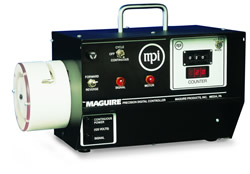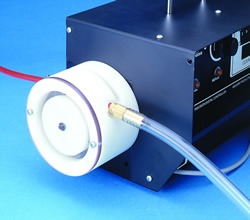

.jpg)


Liquid Color Dosers
The use of liquid colorants lowers material costs due to lower letdown ratios. Less liquid colorant is required to achieve the same final color as pelletized or powdered colorants, since liquid colorants generally disperse easier in the melt stage of processing, than solid colorants. Liquid color is commonly used in tinted clear resins and translucent parts; and opaque parts with letdown ratios of less than 2.0%.
Components associated with liquid color dosing equipment:
- Delivery vessel for liquid color: Since this vessel will be ‘tapped’ for removing the liquid color, it is an important element of the process and typically remains on the production floor, near the process. Common sizes are full sized poly drums as well as 5 gallon containers.
- Pickup lance or wand: This is inserted into the supply vessel by the user, the wand sucks the colorant from the drum when called upon by the pumping system.
- Color pump: A peristaltic, or roller pump, is the standard positive displacement pump used for pumping liquid colorants. The colorant is drawn from the storage container into a flexible tube fitted inside a circular pump casing, which can be located on the drum, in between, or on the machine throat, depending upon the manufacturer. A rotor with a number of "rollers" rotates and compresses the flexible tube. The part of tube under compression closes (or "occludes") forcing the colorant to move through the tube at the time and rate selected on the metering or blending controller.
A new style of pump, recently introduced, uses a compressed air controlled diaphragm to move the liquid colorant. This type of pump is installed directly onto the delivery vessel for maximum cleanliness and precludes the need to ‘tap’ the vessel when starting the coloring process. The pump is pre-installed onto the drum by the liquid colorant supplier, significantly improving cleanliness.
- Metering control: Metering can include at-the-throat units that fit below the standard material supply hopper and work in conjunction with the molding cycles of the processing machine. In these applications, the metering control is coordinated with molding machine operation to feed colorant for a specific duration at a specific time in the machine cycle for proper let-down. The liquid color may also be fed to a multi-component automatic blender to be combined with other materials into a common blend.
- Throat adaptor: When at the throat metering is to be utilized, a nozzle for the introduction of the liquid colorant into the material stream is installed below the material supply hopper on the machine. This component is not required when the metering equipment will be installed on a blender. In this instance the blender is equipped with a liquid color nozzle for connection to the pump.



